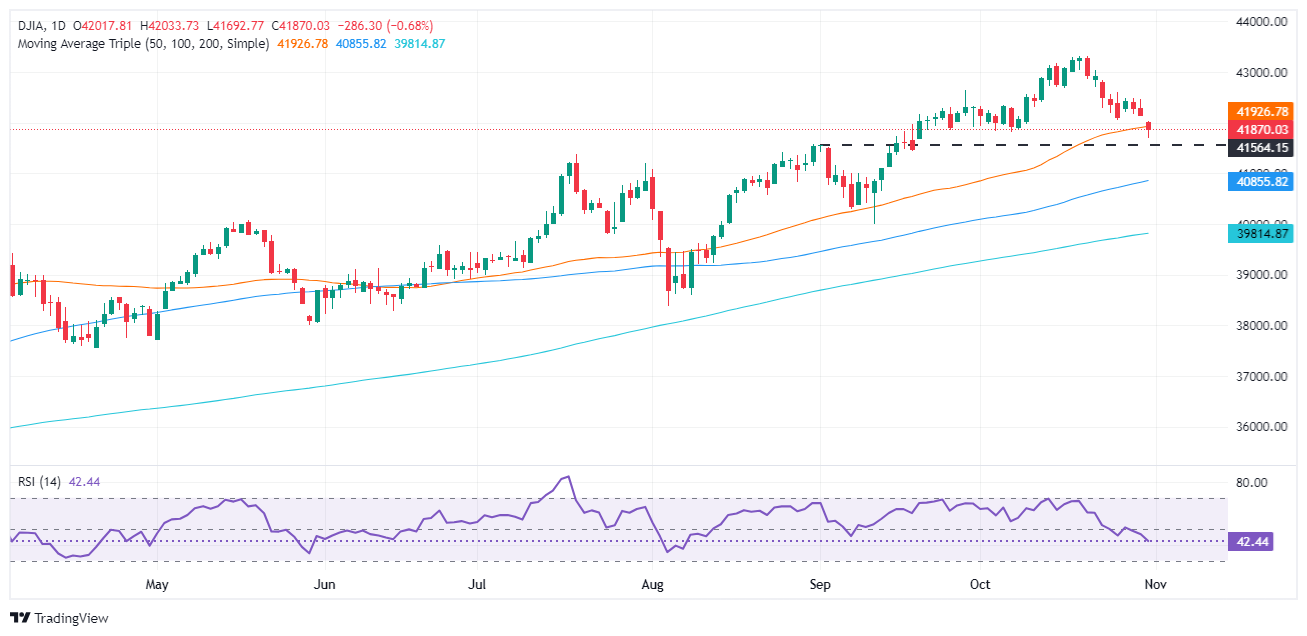- Dow Jones index pressured by rising Treasury yields and significant losses in Microsoft (-5.37%) and Meta (-4%) amid disappointing mega-cap tech guidance.
- Sentiment turns cautious as investors brace for the US presidential election, VIX up over 11%.
- Key support levels for DJIA lie at 41,564 and the 100-day SMA at 40,856, while resistance remains at 42,122 and the October 31 high of 42,460.
The Dow Jones Industrial Average (DJIA) plummeted over 200 points or more than half a percentage point during the North American session on Thursday. US Treasury bond yields spiked, sparked by a jump in global bond yields as traders digested the UK budget. At the same time, Microsoft (MSFT) and Meta (META) dropped by over 5.8% and 4% each, while investors braced for the release of Apple (APPL) and Amazon (AMZN) earnings reports.
Sentiment shifted sour as investors prepare for next week's US election, while US data hinted the Federal Reserve (Fed) wouldn’t need to take aggressive steps to ease policy as jobs data was solid. The US 10-year Treasury note rose as high as 4.333% in the session, while the US Dollar Index (DXY) clung to the 104.00 figure.
Quincy Krosbye of LPL Financial said, “The market overall has been disappointed with mega-tech guidance.” He added that the US presidential election on November 5 would bring more uncertainty, causing a spike in volatility. The CBOE Volatility Index (VIX) rises over 11.46% to 22.67 at the time of writing.
The US Personal Consumption Expenditures (PCE) Price Index dipped in October from 2.2% to 2.1% YoY as expected. Meanwhile, the Fed’s favorite inflation gauge, the core PCE, rose by 2.7% annually, unchanged from September, decreasing traders' hopes for a more dovish US central bank.
Other data showed that Initial Jobless Claims for the week ending October 26 fell to a five-month low. It came at 216K, below estimates of 230K and the previous reading of 227K.
After the data, the CME FedWatch Tool shows odds for a 25 bps rate cut by the Fed reaching 95%, down from 97% a day ago. This would leave rates in the 4.50%-4.75% range.
Dow Jones news
On Wednesday, Microsoft revealed its fiscal Q1 2025 earnings. The company revealed that earnings per share (EPS) were $3.30, exceeding estimates of $3.11, and revenue was $65.59 billion, above forecasts of $64.51 billion. Digging deep into the data, cloud revenue rose to $38.9 billion, above estimates of $38.11 billion, while Intelligent Cloud revenue was $24.09 billion.
At the same time, Amgen (AMGN) earnings beat estimates, but revenue fell short of Wall Street’s consensus. EPS was $5.58 (consensus of $5.11), while revenue was expected at $8.52 billion but was reported at $8.50 billion.
Although the DJIA extends its losses, Verizon (VZ) is up 2.69% at $42.39 a share, followed by Amgen, up 2.69% at $320.59, and Walt Disney (DIS), gaining 1.12% at $96.15. The three main losers are Microsoft, losing over 5.37% to $409.30, followed by Amazon, down 3.12% at $186.72, and Boeing (BA) fell 3.09% at $149.52.
Dow Jones price forecast
The Dow Jones Industrial Average dropped below 42,000 points and extended its losses toward 41,692, below the 50-day Simple Moving Average (SMA) at 41,928. If bears push the DJIA below the 50-day SMA, look for further losses, as they could test the September 2 high turned support at 41,564. If surpassed, traders could test 41,000 ahead of the 100-day SMA at 40,856.
Conversely, if buyers reclaim 42,000, look for a test of the October 30 low, which turned resistance at 42,122. Once cleared, the next stop would be the October 31 high at 42,460.
Otherwise, if the Dow extends its losses below 42,000, then 41,500 would provide the first support.
The momentum shifted to bearish even though the Relative Strength Index (RSI) remains bullish. Nevertheless, it’s aiming downward, accelerating to clear its neutral line.
Dow Jones daily chart
Dow Jones FAQs
The Dow Jones Industrial Average, one of the oldest stock market indices in the world, is compiled of the 30 most traded stocks in the US. The index is price-weighted rather than weighted by capitalization. It is calculated by summing the prices of the constituent stocks and dividing them by a factor, currently 0.152. The index was founded by Charles Dow, who also founded the Wall Street Journal. In later years it has been criticized for not being broadly representative enough because it only tracks 30 conglomerates, unlike broader indices such as the S&P 500.
Many different factors drive the Dow Jones Industrial Average (DJIA). The aggregate performance of the component companies revealed in quarterly company earnings reports is the main one. US and global macroeconomic data also contributes as it impacts on investor sentiment. The level of interest rates, set by the Federal Reserve (Fed), also influences the DJIA as it affects the cost of credit, on which many corporations are heavily reliant. Therefore, inflation can be a major driver as well as other metrics which impact the Fed decisions.
Dow Theory is a method for identifying the primary trend of the stock market developed by Charles Dow. A key step is to compare the direction of the Dow Jones Industrial Average (DJIA) and the Dow Jones Transportation Average (DJTA) and only follow trends where both are moving in the same direction. Volume is a confirmatory criteria. The theory uses elements of peak and trough analysis. Dow’s theory posits three trend phases: accumulation, when smart money starts buying or selling; public participation, when the wider public joins in; and distribution, when the smart money exits.
There are a number of ways to trade the DJIA. One is to use ETFs which allow investors to trade the DJIA as a single security, rather than having to buy shares in all 30 constituent companies. A leading example is the SPDR Dow Jones Industrial Average ETF (DIA). DJIA futures contracts enable traders to speculate on the future value of the index and Options provide the right, but not the obligation, to buy or sell the index at a predetermined price in the future. Mutual funds enable investors to buy a share of a diversified portfolio of DJIA stocks thus providing exposure to the overall index.
Information on these pages contains forward-looking statements that involve risks and uncertainties. Markets and instruments profiled on this page are for informational purposes only and should not in any way come across as a recommendation to buy or sell in these assets. You should do your own thorough research before making any investment decisions. FXStreet does not in any way guarantee that this information is free from mistakes, errors, or material misstatements. It also does not guarantee that this information is of a timely nature. Investing in Open Markets involves a great deal of risk, including the loss of all or a portion of your investment, as well as emotional distress. All risks, losses and costs associated with investing, including total loss of principal, are your responsibility. The views and opinions expressed in this article are those of the authors and do not necessarily reflect the official policy or position of FXStreet nor its advertisers. The author will not be held responsible for information that is found at the end of links posted on this page.
If not otherwise explicitly mentioned in the body of the article, at the time of writing, the author has no position in any stock mentioned in this article and no business relationship with any company mentioned. The author has not received compensation for writing this article, other than from FXStreet.
FXStreet and the author do not provide personalized recommendations. The author makes no representations as to the accuracy, completeness, or suitability of this information. FXStreet and the author will not be liable for any errors, omissions or any losses, injuries or damages arising from this information and its display or use. Errors and omissions excepted.
The author and FXStreet are not registered investment advisors and nothing in this article is intended to be investment advice.
Recommended content
Editors’ Picks

USD/JPY remains below 158.00 after Japanese data
Soft US Dollar demand helps the Japanese Yen to trim part of its recent losses, with USD/JPY changing hands around 157.70. Higher than anticipated Tokyo inflation passed unnoticed.

AUD/USD weakens to near 0.6200 amid thin trading
The AUD/USD pair remains on the defensive around 0.6215 during the early Asian session on Friday. The incoming Donald Trump administration is expected to boost growth and lift inflation, supporting the US Dollar (USD). The markets are likely to be quiet ahead of next week’s New Year holiday.

Gold depreciates amid light trading, downside seems limited due to safe-haven demand
Gold edges lower amid thin trading following the Christmas holiday, trading near $2,630 during the Asian session on Friday. However, the safe-haven asset could find upward support as markets anticipate signals regarding the United States economy under the incoming Trump administration and the Fed’s interest rate outlook for 2025.

Floki DAO floats liquidity provisioning for a Floki ETP in Europe
Floki DAO — the organization that manages the memecoin Floki — has proposed allocating a portion of its treasury to an asset manager in a bid to launch an exchange-traded product (ETP) in Europe, allowing institutional investors to gain exposure to the memecoin.

2025 outlook: What is next for developed economies and currencies?
As the door closes in 2024, and while the year feels like it has passed in the blink of an eye, a lot has happened. If I had to summarise it all in four words, it would be: ‘a year of surprises’.

Best Forex Brokers with Low Spreads
VERIFIED Low spreads are crucial for reducing trading costs. Explore top Forex brokers offering competitive spreads and high leverage. Compare options for EUR/USD, GBP/USD, USD/JPY, and Gold.
